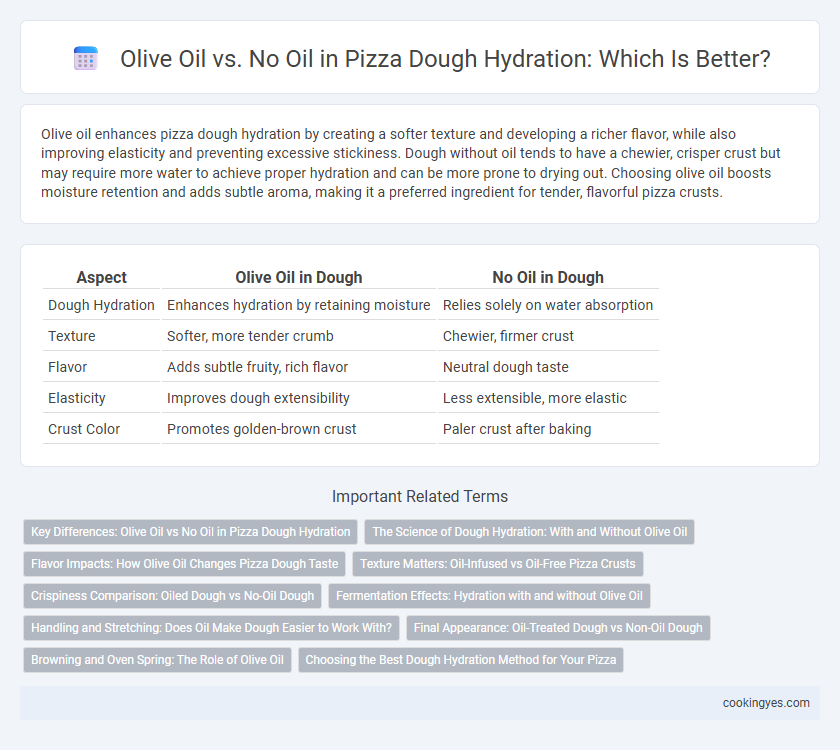Olive oil enhances pizza dough hydration by creating a softer texture and developing a richer flavor, while also improving elasticity and preventing excessive stickiness. Dough without oil tends to have a chewier, crisper crust but may require more water to achieve proper hydration and can be more prone to drying out. Choosing olive oil boosts moisture retention and adds subtle aroma, making it a preferred ingredient for tender, flavorful pizza crusts.
Table of Comparison
| Aspect | Olive Oil in Dough | No Oil in Dough |
|---|---|---|
| Dough Hydration | Enhances hydration by retaining moisture | Relies solely on water absorption |
| Texture | Softer, more tender crumb | Chewier, firmer crust |
| Flavor | Adds subtle fruity, rich flavor | Neutral dough taste |
| Elasticity | Improves dough extensibility | Less extensible, more elastic |
| Crust Color | Promotes golden-brown crust | Paler crust after baking |
Key Differences: Olive Oil vs No Oil in Pizza Dough Hydration
Olive oil in pizza dough enhances hydration by lubricating gluten strands, resulting in a softer, more pliable dough with a richer texture and improved flavor. Dough without oil relies solely on water for hydration, producing a chewier crust with a crisper bite and lighter mouthfeel. The presence of olive oil also slows gluten development and browning during baking, contributing to a distinct crust color and moisture retention compared to oil-free dough.
The Science of Dough Hydration: With and Without Olive Oil
Olive oil enhances dough hydration by creating a tender crumb structure and improving dough extensibility due to its lipid content interacting with gluten proteins. Without olive oil, dough relies solely on water for hydration, resulting in a firmer texture and chewier crust as gluten development is less inhibited. The choice between olive oil and no oil significantly affects dough elasticity, moisture retention, and oven spring during pizza baking.
Flavor Impacts: How Olive Oil Changes Pizza Dough Taste
Olive oil enhances pizza dough flavor by adding a rich, fruity aroma and a subtle buttery taste that deepens the overall profile. The oil's natural compounds interact with flour proteins and sugars, promoting Maillard browning and creating a crispier crust with a more complex, savory flavor. Without oil, dough has a cleaner, more neutral taste that highlights the wheat's natural sweetness but lacks the nuanced flavor layers provided by olive oil.
Texture Matters: Oil-Infused vs Oil-Free Pizza Crusts
Oil-infused pizza dough yields a tender, pliable crust with a rich mouthfeel and enhanced browning, while oil-free dough produces a crispier, chewier texture ideal for traditional Neapolitan-style pies. Olive oil's lipid content disrupts gluten formation, resulting in a softer crumb and improved moisture retention. Choosing between oil or no oil in dough hydration significantly influences pizza crust crispness, chewiness, and overall bite quality.
Crispiness Comparison: Oiled Dough vs No-Oil Dough
Oiled dough typically yields a crisper, more golden crust due to the fat content creating a barrier that slows moisture evaporation, enhancing texture and preventing excessive dryness. In contrast, no-oil dough often results in a chewier and slightly softer crust, as the absence of fat allows more steam to escape during baking. The choice between oiled and no-oil dough impacts the final pizza crust's crunchiness and mouthfeel, catering to different preferences for crispiness.
Fermentation Effects: Hydration with and without Olive Oil
Hydration with olive oil in pizza dough enhances fermentation by promoting gluten development and creating a tender crumb structure, resulting in a more elastic and flavorful crust. Without oil, dough fermentation tends to produce a chewier texture with a slightly crisper crust due to faster moisture evaporation and a tighter gluten network. Olive oil also aids in retaining gas during fermentation, leading to improved dough rise and a softer, more aromatic pizza base.
Handling and Stretching: Does Oil Make Dough Easier to Work With?
Olive oil in pizza dough improves handling and stretching by creating a softer, more pliable texture that resists tearing. Dough without oil tends to be stickier and less elastic, making it more challenging to stretch evenly without breaking. The presence of oil also helps reduce surface friction, allowing for smoother shaping and a more manageable dough feel.
Final Appearance: Oil-Treated Dough vs Non-Oil Dough
Oil-treated dough creates a glossy, golden crust with a slightly crisp texture, enhancing the pizza's visual appeal. In contrast, non-oil dough tends to have a more rustic, matte finish with a chewier bite. The presence of olive oil in dough hydration influences the final appearance by promoting better browning and a tender crumb structure.
Browning and Oven Spring: The Role of Olive Oil
Olive oil in pizza dough enhances browning through the Maillard reaction by increasing sugar caramelization and promoting a crisp crust with a golden hue. Dough hydration with olive oil improves oven spring by creating a more extensible and tender crumb structure that traps gas bubbles during baking. Without olive oil, dough may lack this enhanced coloration and rise quality, resulting in a paler, denser crust.
Choosing the Best Dough Hydration Method for Your Pizza
Choosing the best dough hydration method for pizza significantly affects texture and flavor. Olive oil in dough hydration enhances elasticity and creates a tender crumb while contributing a subtle fruity aroma, ideal for Neapolitan or artisan-style pizzas. Hydrating dough without oil produces a chewier crust with a crisp exterior, favored for traditional New York-style pizzas or those seeking a crisp bite.
Olive oil vs No oil for dough hydration Infographic

 cookingyes.com
cookingyes.com